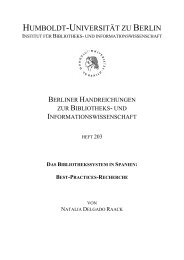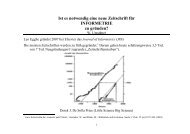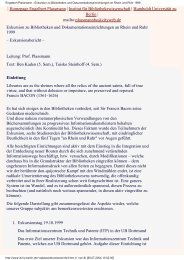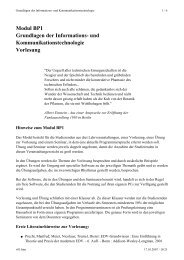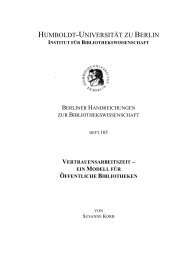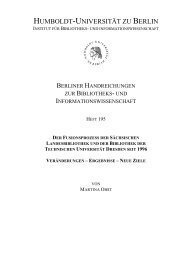An exploratory study of Google Scholar
An exploratory study of Google Scholar
An exploratory study of Google Scholar
You also want an ePaper? Increase the reach of your titles
YUMPU automatically turns print PDFs into web optimized ePapers that Google loves.
ibliometrics and informetrics. Researchers from this field compare the new <strong>Google</strong> <strong>Scholar</strong><br />
service with the established citation indices Web <strong>of</strong> Science (WoS) and Scopus (Bauer and<br />
Bakkalbasi, 2005; Belew, 2005; Noruzi, 2005; Kousha and Thelwall, to appear) or other<br />
citation databases (e.g. CiteSeer, see Bar-Ilan, 2006). Most <strong>of</strong> these studies are basing on<br />
small samples and applying different methodologies. Bauer and Bakkalbasi stated that<br />
‘<strong>Google</strong> <strong>Scholar</strong> provided statistically significant higher citation counts than either Web <strong>of</strong><br />
Science or Scopus’, but this result is based on the analysis <strong>of</strong> only one journal and two<br />
different journal volumes. They also say that older material from the analyzed journal is<br />
covered better by WoS. Belew (2005) applauds the ‘first independent confirmation <strong>of</strong> impact<br />
data’ but also identifies significant variations in the counts between the ISI/WoS and the<br />
<strong>Google</strong> citation database. Belew and Bauer and Bakkalbasi also mentioned that <strong>Google</strong><br />
<strong>Scholar</strong> could possibly cover the Open Access/self archiving web publishing fraction better<br />
than the traditional citation activity WoS. Noruzi (2005) compared citations counts for highly<br />
cited papers in the webometrics field. He found a certain overlap between <strong>Scholar</strong> and WoS<br />
and a good ratio <strong>of</strong> additional papers for <strong>Google</strong> <strong>Scholar</strong>. Kousha and Thelwall (to appear)<br />
compared traditional and web-based citation patterns <strong>of</strong> Open Access articles in multiple<br />
disciplines. They found ‘significant correlations and overlaps between ISI/WoS citations and<br />
both <strong>Google</strong> <strong>Scholar</strong> and <strong>Google</strong> Web/URL citations’ in all disciplines studied. Correlation<br />
between ISI/WoS citations and <strong>Google</strong> <strong>Scholar</strong> citation are stronger than ISI/WoS correlated<br />
with <strong>Google</strong> Web citations. Kousha and Thelwall concluded from their interesting <strong>study</strong> that<br />
it could be said that <strong>Google</strong> <strong>Scholar</strong> had a ‘widely applicable value in citation counting,’ but<br />
that <strong>Scholar</strong>’s limitations must also be noted.<br />
Our <strong>study</strong> was carried out as an alternative attempt to create a more accurate picture <strong>of</strong><br />
<strong>Google</strong> <strong>Scholar</strong>’ current situation. Compared with the former studies, it utilizes a brute force<br />
approach to give a more macroscopic view on the content indexed by <strong>Scholar</strong>. Our <strong>study</strong> uses<br />
brute force in the sense that we gathered a lot <strong>of</strong> data from <strong>Google</strong>, and analyzed the data in a<br />
macroscopic fashion. The following <strong>study</strong> addresses the question: How deep does <strong>Google</strong><br />
<strong>Scholar</strong> dig? The <strong>study</strong> should make it possible to answer these research questions:<br />
• How complete is <strong>Google</strong> <strong>Scholar</strong>’s coverage <strong>of</strong> different scientific journals on a<br />
general level? By querying multiple journal lists the <strong>study</strong> tests whether <strong>Google</strong><br />
<strong>Scholar</strong> has indexed the journals and can display the articles. The journal lists come<br />
from widely varying subject areas: international peer-reviewed journals from the Web<br />
<strong>of</strong> Science (http://scientific.thomson.com/products/wos/) (particularly Science,<br />
Technology & Medicine), Open Access and social sciences, and enable conclusions to<br />
be drawn about the thematic focus <strong>of</strong> the current <strong>Google</strong> <strong>Scholar</strong> <strong>of</strong>fering. Is <strong>Scholar</strong><br />
touching the academic invisible web (compare Lewandowski and Mayr, 2006)?<br />
• Which document types does <strong>Google</strong> <strong>Scholar</strong> deliver? Are theses results sufficient for<br />
pr<strong>of</strong>essional searchers and academic researching? The analyzed data gives indications<br />
about the composition and utility <strong>of</strong> the results delivered by <strong>Scholar</strong>: full-text, link<br />
and citation.<br />
• From which providers does <strong>Google</strong> <strong>Scholar</strong> take the bulk <strong>of</strong> the documents retrieved?<br />
The <strong>study</strong> should show who the most prominent providers <strong>of</strong> data for this new service<br />
are, and which sources for scientific information are actually underrepresented in the<br />
index. The distribution <strong>of</strong> the web servers and providers is significant as it is an<br />
indicator <strong>of</strong> whether <strong>Google</strong> <strong>Scholar</strong> delivers more pay per document or freely<br />
accessible documents.<br />
7






